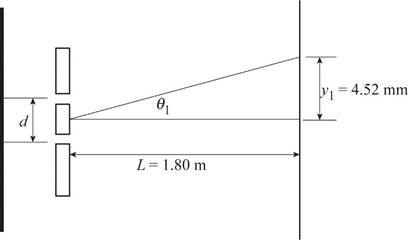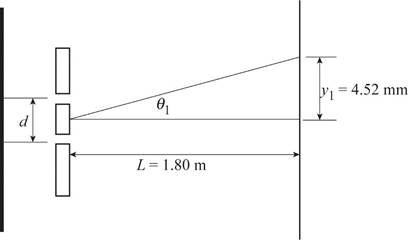
Concept explainers
Monochromatic
(a)
Answer to Problem 14P
Following figure shows the first bright fringe formation.

Explanation of Solution
Following figure shows the first bright fringe formation.

Here,
Conclusion:
Following figure shows the first bright fringe formation.

(b)
Answer to Problem 14P
Explanation of Solution
Given info:
The distance between the central maxima and the first bright fringe is
The screen separation is
Explanation:
Formula to calculate the tangent of the angle associated with the first order bright fringe is,
Substitute
Conclusion:
The tangent of the angle associated with the first order bright fringe is
(c)
Answer to Problem 14P
Explanation of Solution
Formula to calculate the angle associated with the first order bright fringe is,
Substitute
Formula to calculate the sine of the angle associated with the first order bright fringe is,
Substitute
The sine and the tangent of the angle are nearly same since the angle is very small. For larger angle the sine and tangent will not be comparable.
Conclusion:
The angle associated with the first fringe is
(d)
Answer to Problem 14P
Explanation of Solution
Given info:
The slit separation is
The order of first bright fringe is
Explanation:
Formula to calculate the wavelength is,
Here,
Substitute
Conclusion:
The wavelength of the light is
(e)
Answer to Problem 14P
Explanation of Solution
Given info:
The order of fifth bright fringe is
Explanation:
Formula to calculate the angle of fifth order bright fringe is,
Substitute
Conclusion:
The angle of the fifth order bright fringe is
(f)
Answer to Problem 14P
Explanation of Solution
Formula to calculate the position of the fifth bright fringe is,
Here,
Substitute
Conclusion:
The position of the fifth bright fringe on the screen is
Want to see more full solutions like this?
Chapter 24 Solutions
College Physics
- For 600-nm wavelength light and a slit separation of 0.12 mm, what are the angular positions of the first and third maxima in the double slit interference pattern?arrow_forwardConsider a single-slit diffraction pattern for =589 nm, projected on a screen that is 1.00 m from a slit of width 0.25 mm. How far from the center of the pattern are the centers of the first and second dark fringes?arrow_forwardA Fraunhofer diffraction pattern is produced on a screen located 1.00 m from a single slit. If a light source of wavelength 5.00 107 m is used and the distance from the center of the central bright fringe to the first dark fringe is 5.00 103 m, what is the slit width? (a) 0.010 0 mm (b) 0.100 mm (c) 0.200 mm (d) 1.00 mm (e) 0.005 00 mmarrow_forward
- A beam of monochromatic green light is diffracted by a slit of width 0.550 mm. The diffraction pattern forms on a wall 2.06 m beyond the slit. The distance between the positions of zero intensity on both sides of the central bright fringe is 4.10 mm. Calculate the wavelength of the light.arrow_forwardWhy is it much more difficult to see interference fringes for light reflected from a thick piece of glass than from a thin film? Would it be easier if monochromatic light were used?arrow_forwardWhen a monochromatic light of wavelength 430 nm incident on a double slit of slit separation 5 m, there are 11 interference fringes in its central maximum. How many interference fringes will be in the central maximum of a light of wavelength 632.8 nm for the same double slit?arrow_forward
- Using the result of the problem two problems prior, find the wavelength of light that produces fringes 7.50 mm apart on a screen 2.00 m from double slits separated by 0.120 mm.arrow_forwardConsider the perpendicular reflection of light of wavelength 520 nm in air from a soap film with refractive index 1.32 that has air on both sides. Find the thickness, in nanometers, of the thinnest soap film that will cause constructive interference for the reflected light. t =?arrow_forwardOn the soap film (n=1,3), which is in the air, a normal beam of white light rays falls. At what is the smallest thickness d of the film, the reflected light with a wavelength of 0.65 microns will be maximally attenuated as a result of interference?arrow_forward
- In a single-slit diffraction experiment, monochromatic light of wavelength 505 nm is passed through a slit 0.320 mm wide, and the diffraction pattern is observed on a screen 7.14 m from the slit. The intensity at the center of the pattern is ?0. What is the ratio of the intensity at the center of the pattern to the intensity at a point 3.09 mm from the center of the diffraction pattern (?/?0)?arrow_forwardConsider a 455 nm wavelength blue light falling on a pair of slits separated by 0.075 mm. At what angle (in degrees) is the first-order maximum for the blue light?arrow_forwardIn a double slit experiment, if the separation between the two slits is 0.050 mm and the distance from the slits to a screen is 2.5 m, find the spacing between the first-order and second-order bright fringes when coherent light of wavelength 600 nm illuminates the slits. A) 1.5 cm B) 3.0 cm C) 4.5 cm D) 6.0 cm E) 9.0 cmarrow_forward
 Principles of Physics: A Calculus-Based TextPhysicsISBN:9781133104261Author:Raymond A. Serway, John W. JewettPublisher:Cengage Learning
Principles of Physics: A Calculus-Based TextPhysicsISBN:9781133104261Author:Raymond A. Serway, John W. JewettPublisher:Cengage Learning University Physics Volume 3PhysicsISBN:9781938168185Author:William Moebs, Jeff SannyPublisher:OpenStax
University Physics Volume 3PhysicsISBN:9781938168185Author:William Moebs, Jeff SannyPublisher:OpenStax Physics for Scientists and Engineers: Foundations...PhysicsISBN:9781133939146Author:Katz, Debora M.Publisher:Cengage Learning
Physics for Scientists and Engineers: Foundations...PhysicsISBN:9781133939146Author:Katz, Debora M.Publisher:Cengage Learning Glencoe Physics: Principles and Problems, Student...PhysicsISBN:9780078807213Author:Paul W. ZitzewitzPublisher:Glencoe/McGraw-Hill
Glencoe Physics: Principles and Problems, Student...PhysicsISBN:9780078807213Author:Paul W. ZitzewitzPublisher:Glencoe/McGraw-Hill



